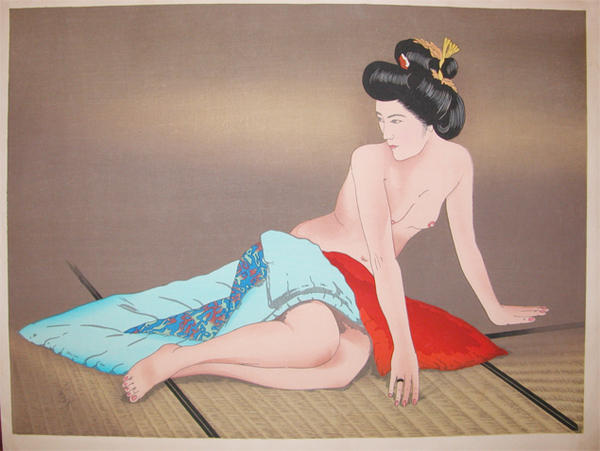| Artist Bio: |
From the WISCONSIN ALUMNUS.: THERE'S NOT ONE American who has ever become a
master craftsman in the ancient Japanese art of color
wood-block printing. But Major Vincent Hack, '36, Falls
Church, Va., has probably progressed as far toward this goal
as any of his countrymen -and in another eight years he
hopes to attain that high rank.
It was back in 1947 that Maj. Hack, a medical artist,
arrived in Tokyo. He immediately searched out a wood-
block artist, Hiroshi Yoshida. "Teach me," the major asked,
"to make wood-block color prints."
Yoshida referred Major Hack to a wood-block cutter, the
cutter referred him to a printer, the printer referred him
Major and Mrs. Hack look over some of his fine color printing.
36
to another printer. It was, the major realized, the old run-
around. He went back to Yoshida, and after a year of per-
severance, won an offer of help as a result of a favor
rendered.
He spent the next six months learning color analysis. A
Japanese wood-block artist analyzes the picture he wishes to
reproduce to decide the colors he needs. He plans one wood-
cut for each color. He may plan two woodcuts or 30, gain-
ing range and subtlety as he increases the number. Then
the proper design is painstakingly carved on each block-
each swirl of color is duplicated precisely in wood. Next,
a printer brushes the proper colors on the blocks and rubs
a specially-made paper against each block in turn, varying
intensity of the colors by varying his pressure. Some author-
ities call the Japanese wood-block art the world's highest
developed color printing.
After Maj. Hack learned color analysis, he still had a
long way to go. He located a master cutter, and by dint
of more lengthy persuasion, extracted from him a promise:
"You will be a No. 1 American cutter."
The master cutter required Maj. Hack to hold an egg
against the handle of the cutting knife. If the egg broke,
it proved he was not using a delicate touch. For economy,
the cutter furnished only rotten eggs. After breaking a few,
Maj. Hack brought his own, fresh ones.
Before leaving Japan in 1951, Maj. Hack saw his prints
hanging in Japanese exhibitions. Some Japanese viewers
thought they were seeing a new school of wood-block print-
ing. Maj. Hack explains that he gives the faces of his sub-
jects more characterization than the Japanese do.
Maj. Hack is now with the Armed Forces Institute of
Pathology in Washington. He spends many off-duty hours
with his cherry-wood blocks. It requires about eight months
from conception of a painting to completion of prints.
|
|


